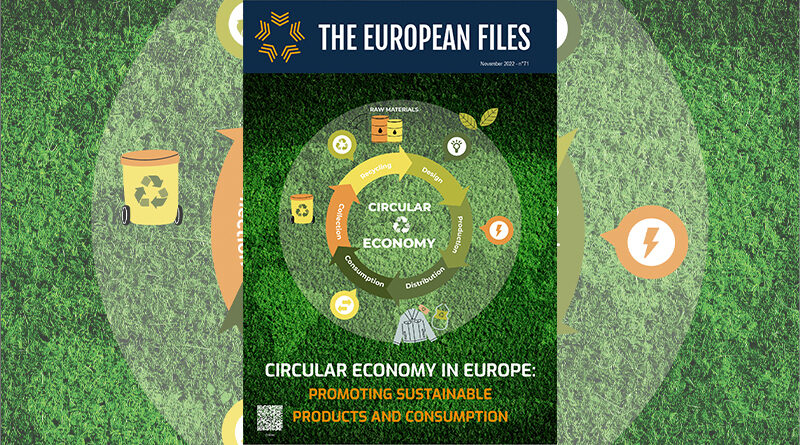
Circular Economy in Europe: Promoting Sustainable Products and Consumption
Today’s world is caught in increasingly frequent and fierce geopolitical, economic, and demographic tensions and stakes that are undermining our economies. Each new crisis reveals and emphasises Europe’s external resource dependency.
With each passing day, the competition for scarce resources is intensifying and forces us to do more with less.
Europeans’ awareness of the scarcity of raw materials is driving economic and institutional players to hasten the implementation of a more virtuous system of consumption and recycling of goods.
Circularity is one of the best opportunities for economies and businesses to address growing climate concerns while generating growth and new jobs.
With the Green Deal, the EU is leading the transition towards a circular economy.
Following the adoption in 2020 of a Regulation on Ecodesign for sustainable products and the EU Strategy for sustainable and circular textiles, a new string of initiatives focusing on packaging is underway.
The Ecodesign for sustainable products Regulation, which is currently being discussed in the European Parliament, will play a significant role in defining how our products are designed in the future. We need to ensure that our products are so designed as to have the longest possible life cycle and to be reusable and recyclable throughout the value chain. In other words, we need to ‘design without waste’.
This new legislation introduces a ‘design for recycling’ approach and proposes a recyclability assessment process, with the aim of setting Europe-wide criteria for packaging design.
One of the innovations put forth by the proposed Regulation is a new European digital product passport, which will require products to be labelled with, identified by, and linked to data relating to their circularity and sustainability.
Furthermore, the introduction of a reparability index would allow buyers to understand how easy their products can be repaired. The establishment of a European register which lists reliable labels and allows their easy identification would contribute to effective implementation.
The transition to a more circular economy must be based on a shock of investments in recycling, sorting and waste recovery infrastructures; an obligation for all to recycle (citizens, administrations, economic actors from all sectors); coupled with a regulatory obligation to reincorporate recycled materials. The regulatory obligation to reincorporate creates the conditions for the emergence of sustainable downstream markets for recycled materials in Europe.
The role of local and regional authorities is of utmost importance. Business and civil society initiatives are key to realising a circular economy in Europe. Owing to the powers at their disposal, regional and local authorities are the main initiators of public procurement in Europe, which makes them an important promotion tool.
Supporting companies in their transition towards a circular economy with the development of Public Private Partnerships in different key sectors (ICT, batteries, packaging, plastics, textiles, construction, foodstuffs), would be of great benefit.
Europe must become the first climate neutral continent in the world while increasing the sustainability and circularity of its production and consumption patterns. We need to create the proper ecosystem that challenges us to rethink the way we procure, transform, and use the resources we need.
Circularity is key to achieving meaningful change for our planet and is of utmost importance for securing the EU’s strategic autonomy.
It is only by accelerating the transformation of our product and material production, consumption, and management patterns that we can work at the heart of current crises and build a more resilient Europe.
It’s a paradigm shift that we are talking about here, which will not take place overnight, but circularity needs to become mainstream, and not the exception. What’s at stake with this shift ? Securing Europe’s long term productivity and attractiveness, in a sustainable way.
Editor-in-Chief
Laurent ULMANN
Circular economy – the high road to strategic autonomy
, Commissioner for Environment, Oceans and Fisheries, European Commission
Cleaner and more sustainable fashion industry calls for ambitious collaboration at the European level
, Dutch Minister for the Environment
Transform sectors that use most resources into circular systems
, Minister of Economic Affairs, Finland
How renewable materials can power a circular economy
, Vice-President of the European Investment Bank
Resource efficiency and circular economy: essential for our economies and our environment
, Head of the Environment and Economic Integration Division, OECD Environment Directorate
, Circular Economy Team Lead, Environment and Economic Integration Division, OECD Environment Directorate
, Senior Economist, Environment and Economic Integration Division, OECD Environment Directorate
, Junior Environmental Policy Analyst, Environment and Economic Integration Division, OECD Environment Directorate
Turning waste into a resource
, Director-General, for Environment at the European Commission, offers a preview of, the coming revision of EU legislation on packaging and packaging, waste
Saving climate and biodiversity: there is no alternative but to rely on circular economy
, Deputy secretary assistant for green economy, Ministry for ecological transition, France
New models of industrial cooperation in materials recycling to strengthen the European circular economy
, CEO of Paprec Group
I.Enabling the green transition through an effective policy framework
The role of Circular Economy Actors in Europe
, EESC Vice-President in charge of Communication
Ecodesign of products: the condition to put an end to the waste economy
, MEP (Greens/EFA- France), IMCO Member
Unlocking circularity through innovation and collaboration
, Executive Vice President for Packaging Solutions, Tetra Pak
A climate neutral, resource efficient and circular economy
, MEP (EPP Group. – Finland), Member of the Committee on Economic and Monetary Affairs
The critical role of reuse in the transition to sustainable production and consumption
, Executive Director of Zero Waste Europe
Flipping the script in buildings and heating: from resource depletion into regenerative business models
, Vice President Global Public Affairs and Sustainability, Viessmann Group
Walking on two legs: mitigating climate change also means building carbon circularity with CCU technologies
, Senior Policy Manager at CO2, Value Europe
Ready for Circular Economy: Turning textiles inside out
, MEP (S&D Group – Germany), Member of the ENVI Committee
Creating the right ecosystem for the circular economyMaria da Graça Carvalho, MEP (EPP Group – Portugal), ITRE Member
For Europe’s manufacturing , a circular bio-economy should not be a problem to regulate but a transition to encourage
, Director General Cepi, the Confederation of European Paper Industries
Circularity of global plastics value chains – combining environmental ambition with economic opportunity
, Adviser for International Negotiations in DG Environment, coordinates, and serves as EU lead negotiator in the negotiation for a Global Biodiversity Framework under the Convention on Biological Diversity and its Protocols and for a new Global Agreement on Plastics.
Europe should step up its circular transition to tackle global biodiversity loss
, Specialist, Sustainability solutions, Finnish Innovation Fund, Sitra
Strengthening local business structures by improving durability and reparability of products
MEP (Greens Group – Germany), Member- Committee on the Environment, Public Health and Food Safety
II. Strengthening Europe’s competitiveness through better circularity of value chains
A competitive bioeconomy for a sustainable future
, CBE JU Executive Director ad interim
Basing the European Green Deal’s aspirations for packaging and circularity on evidence and facts
, Chair, Fibre Packaging Europe
Re-designing the future for sustainable business development
, Chief Sustainability Officer, Inter IKEA Group
New EU corporate reporting standards could help companies become more circular – if done right
, Programme Manager, Environmental Coalition on Standards (ECOS)
Laying down measures, the key to food waste prevention in Europe
, MEP (EPP Group – Romania), REGI Committee Member
Target packaging waste, not packaging circularity
, Director General of UNESDA Soft Drinks Europe
Broad European Coalition support ambitious action on Circular Beverage Packaging
, Chief Executive, Reloop Platform
Bringing science to the packaging debate
, FEFCO’s Director General
Ethics , Economics and the Environment: The case for phasing out plastic waste exportation
, MEP (S&D Group – Malta), Member of the ENVI Committee
III. Empowering consumers and creating new jobs
Rules for sustainable products are one side of the coin. Enforcing them is the other
, Director General of BEUC
Circular claim : how to better involve consumers into the loop ?
, CEO of CITEO
Empowering consumers for the green transition – combatting greenwashing and obsolescence
, Policy Officer for Sustainable Consumption, European Environmental Bureau
, Policy Officer for Circular Economy, European Environmental Bureau
Putting cities and regions at the heart of the circular economy
, Secretary General, AISBL ACR+



